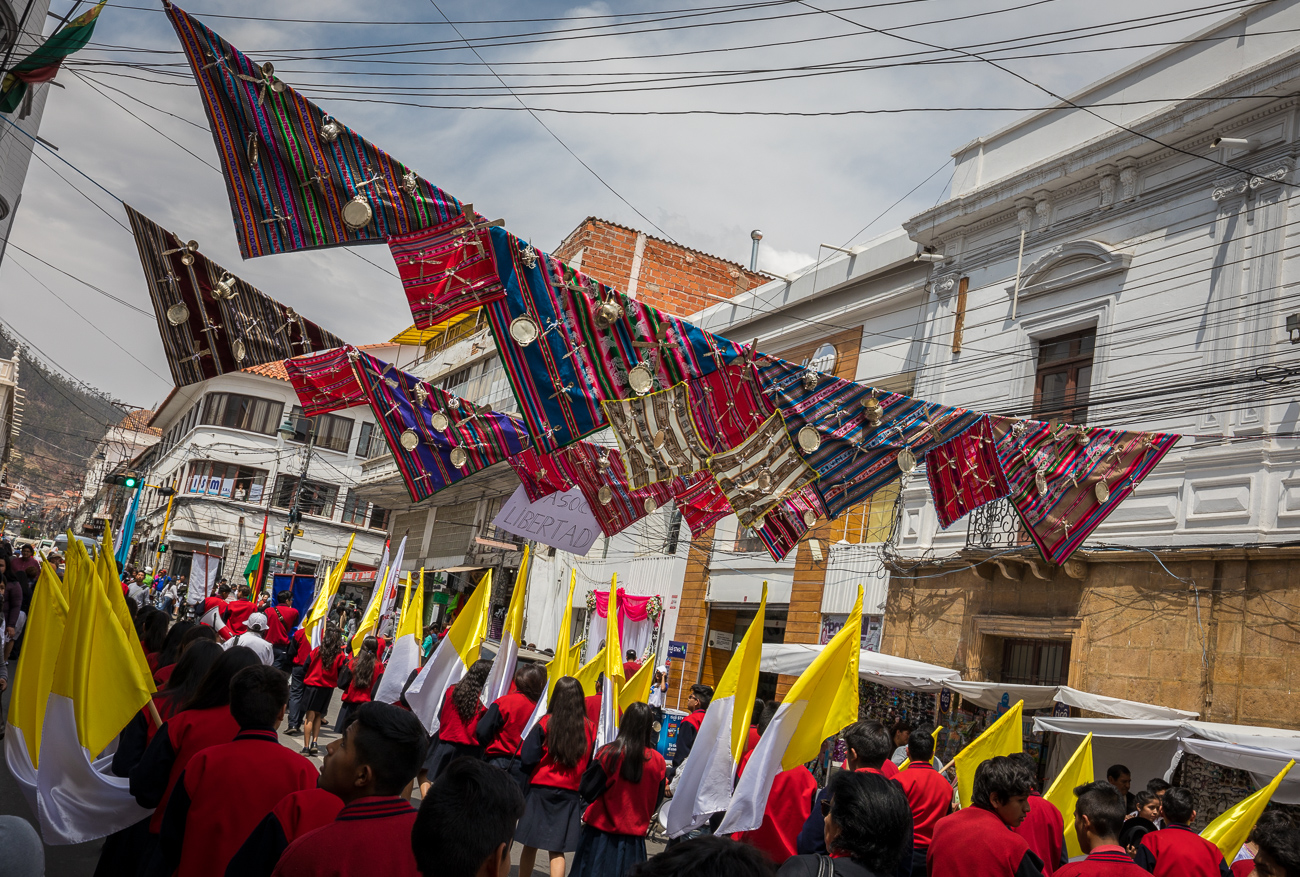We stayed in Samapaita for two nights. Our next destination was Sucre, on the other side of the Eastern Andes. This turned out to be one of the longest, if not THE longest, drive i’ve ever done. It took us 13 hours in total and almost the entire drive was on dirt roads or cobbled streets. Crossing the Andes was amazing and involved driving through several incredibly deep valleys. We began to learn how scarce normal services can be, with some towns only selling gas through kitchen windows and many towns with no place to buy worthwhile nutrition. At one point we even had to turn around and drive back 20 minutes because we had forgotten to get gas at the last significant town for 100’s of miles.

Sunset in the middle of nowhere. This was the only picture I took that day. We had been driving around 10 hours at this point, we had to cross all the mountains you can see, it was sunset, and we could see lightning flashes in the distance.
We were so pressed for time and the driving was so slow that i only took one picture of the trip. I regret that because we went through so much varied and amazing scenery but we really were that far behind schedule. A few notable experiences that day was driving through a vast area of burned hills and ghost towns, driving through a storybook, medieval looking village, driving on a cobblestone road for over 100 miles (not fun, but an incredible amount of work must have been involved to build that road), navigating over half a dozen mud slides, at night, that were only hours old, and finally busting through a police barricade and not stopping!

Downtown Sucre is in a shallow depression.

Our hotel was a maze of courtyards, stairwells and hallways.


A narrow stairway in our hotel led to one of two rooftop patios.

A typical hallway at The Parador.

There was always something new to discover, including a cave like catacomb. I enjoyed Hotel Parador Santa Maria La Real.
Day 4: Sucre
Sucre is constitutional Capital of Bolivia but more importantly, the Chocolate Capital of Bolivia. There are indeed a lot of chocolate stores. We were in a nice hotel again and it was in a good location. We spent the day semi-randomly roaming the town, watching the festival, and going to museums. Our car was buried deep underground and after running from the police we decided it would be a good idea to lay low and simply walk around all day in the crowds.
I think we had made it to Sucre by about 10:30pm and looked forward to sleeping in. We did not get to sleep in. We had arrived on the weekend festival celebrating the Virgin of Guadalupe. Our Lady of Guadalupe was a holy figure combining the Catholic Virgin Mary with the Aztec Mother Goddess, Tonantzin Coatlaxopeuh, through the story of an apparition that left a miracle artifact similar to the shroud of Turin. Some people say that combining the most holy figures from two extremely different religions came in handy when the Spanish needed to baptise 8 million Aztecs and convert them to Catholicism. That day of the festival began with extremely loud fireworks at 4:30am followed by a loud marching band that seemed to be going in circles.

The town square was completely surrounded by a parade of decorated cars.


The cars were decorated with all kinds of random stuff but there seemed to be a pattern of dishes, money, paintings and stuffed animals, especially pink teddy bears.



This car had a prodigal son and an entire orange tree! It was my favorite.

Once the envoy got going they circled the square a number of times and then drove off down the streets followed by a marching parade of school students.

When we’d had enough of the festivities we started looking for food and wandered into a chaotic market.


Sucre reminded me of a grittier version of Cuzco, Peru. Both towns are at a high elevation and end suddenly in rolling plains and distant mountains. Compare my pictures of that city.


As the day wore on we tired of central downtown and ventured into a more suburban, quieter part of the city.


One building with a large plaza in front of it was guarded by these two male and female dogs.

The glow of afternoon light.

I was on the roof of our hotel when I saw these people on the roof of a church. I don’t know if you could pay to get up there or not, but the view I had was the same.
One of the old churches.


Ben is obsessed with textiles so we went to at least two textile museums. I have to admit once you are forced to look at them they are pretty interesting. There were two modern styles shown here above and below. The top style usually tells a story. The imagery is a literal depiction of the story. The artists have a tendency to put green and magenta stripes down the middle of the tapestry, which drove me nuts because those colors are the same as chromatic aberrations.
The other style is more mythical, more malleable and features psychedelic animal patterns, as seen below.



Sucre is known for it’s large number of dinosaur fossils and footprints just outside of town. You can find dinosaurs around the city.


No matter what kind of restaurant you are in, you can expect to be given an single small napkin for your dinner. Bolivians are tidy eaters. At one restaurant we tried some local microbrews. The one on the left was pretty good and the one on the right had coca in it.
